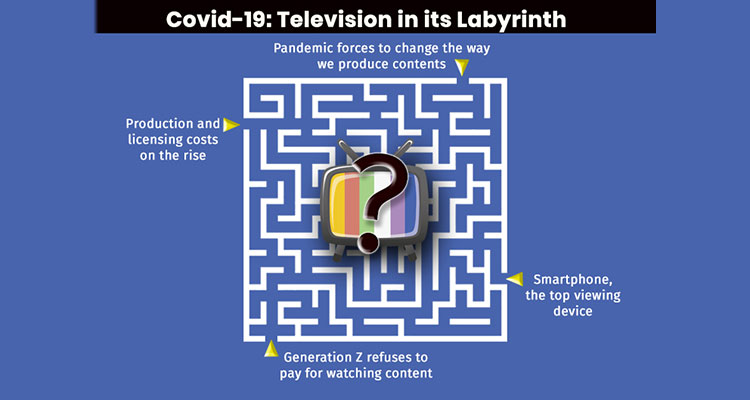
Television in all its forms, and especially linear FTA (free-to-air) and Pay TV, faces a complex present and an even more complicated future. This is due to a series of circumstances that place it in a situation that requires solutions, both technological and conceptual, to keep growing.
There are a number of reasons, of which we will focus on four, emerging from situations independent among themselves. The Covid-19 pandemic is one of them, but it acts as an accelerator and reinforcer in the integration of the remaining three into something more complex and difficult to solve. We are going to analyze them and see how the resultant dangers can be mitigated.
These conditions are:
a) The pandemic forces us to change the way we produce content. Physical proximity of actors and technicians is risky, a large part of shooting has been postponed, and what must be broadcast «live» must respect strict rules of distancing. This could be partly solved, in the medium term, by software based on what is used in cinematography to generate visual effects scenes, as in the HBO series ‘I Know this much is true’, with Mark Ruffalo playing twin brothers. This is a technological challenge, but it is also going to be expensive not to have it. On the other hand, in recent years there has been a great increase in the production of new product, to satisfy the demand of Netflix, Amazon Prime Video and others. But, these production restraints will affect output throughout this year and force people to search Hollywood archives and other content sources. And will result in latent demand, due to the need for OTTs to permanently ‘refresh’ their offer to avoid subscriber fatigue and churn.
b) Generation Z refuses to pay for watching content: young people used to the Internet and its supposedly free content are mostly reluctant to pay for scheduled audiovisual experiences. And, when they do, they have lower acceptance limits (the famous iTunes $1 threshold). This is felt by linear cable and satellite pay TV operators through the so-called “cord cutters” (those that ‘cut’ the cable) and the “cord nevers”, which have been never subscribed. The problem is accentuated in countries where there is abundant supply of over-the-air TV channels, offering a greater variety of programming, than in regions where options are scarce. The other triggering factor is growing Internet penetration, which has surpassed that of pay TV in most countries and offers opportunities to “influencers”, people attractive to audiences that, jointly with the social networks, are obtaining a growing proportion of the advertising budgets of advertisers previously focused on radio, television and print media.
c) Smartphone, the top viewing device: The ‘anytime, anywhere’ leads the also growing group of users who own “smartphones” to discard linear television as a means of entertainment, turn to consuming online content every time they have free time. Although free and pay television stations do offer an increasing proportion of their content online, young users are not attracted to this and prefer videogames (participatory rather than passive experience), short videos-–TikTok, Instagram — and the “influencers” company, who on the big screen would be pathetic but on phones seem to exercise a kind of ‘accompanied privacy’.
d) Production costs and licensing costs on the rise: with increasingly ambitious and expensive productions, frequently exceeding one million dollars per episode, fiction co-productions among different media and different countries have become widespread –this is particularly visible in Scandinavia– that allow these investments. This also complicates the life of linear sports channels, resulting in growing economic unviability, despite the strong advertising revenues resulting from millions of users. The “piracy” (illegal transmission, without rights) of this content is another headache and has been fought –until now– effectively, because differences arise between the parties regarding who should bear the costs and legal procedures needed to detect and punish offenders. The problem is common to both linear and streaming systems, and much more serious in the digital environment than it was in the analog.
Unlike the pandemic, none of these problems is fatal, but the influence of these and other factors will be reflected in the near future, and can derail many well-aligned projects. The Streaming industry is based on the “Silicon Valley” model of constant market expansion, unlike the “Hollywood” model that requires making money at each stage of a product’s trajectory, in this case audiovisual content. Today, no one has the full answer and, as in all times of disruption, «mistakes are cheap» while business plans require re-adaptation (based on the user data received) to improve results.
Exiting the labyrinth is possible, but there is a latent risk that many people and TV companies will remain trapped inside. Hopefully not.

